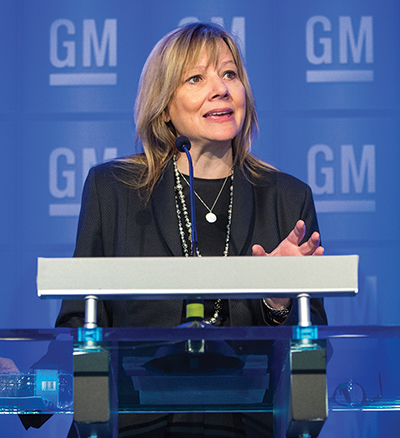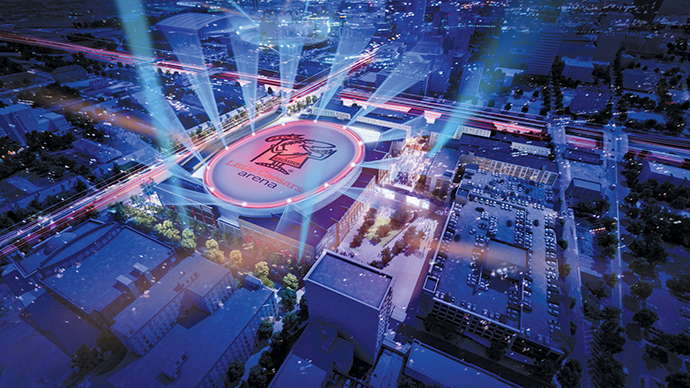When did it all start?
Pinpointing milestones in Michigan’s history of automotive innovation can be like finding a particular star on a clear, dark northern night: There are just too many to choose from.
But the latest star is shining bright, as advanced manufacturing, autonomous vehicle and mobility projects have come in a flurry over the past year. They include new research collaboration agreements with Ontario and with China, and, in November, the cinching of a deal to develop the new American Center for Mobility (ACM) at the former World War II aircraft and GM complex at Willow Run in Ypsilanti.
RACER Trust (Revitalizing Auto Communities Environmental Response) is the entity created to clean up and position for redevelopment properties and other facilities owned by the former General Motors Corp. before its 2009 bankruptcy. The Trust sold the property to Willow Run Arsenal of Democracy Landholdings Limited Partnership for $1.2 million. That partnership will in turn lease the property to the ACM. It wasn’t the only November deal for RACER, which also announced it had entered into agreements with NorthPoint Development for the sale and development of industrial property in the City of Lansing, Lansing Township and Delta Township. NorthPoint plans to build a mix of manufacturing, warehouse and distribution facilities, primarily for companies in the automotive sector.

In Ypsilanti, the ACM will be designed for research, education, testing, standards-convening, product development, validation and self-certification for connected and automated technologies as well as future mobility. With plans to open for business in December 2017, it will be available for use by private industry, government, standards bodies and academia and will serve as a technology hub, allowing companies to lease office space, garages and other amenities. The state has committed an initial $25 million to the ACM’s development, as it builds interest in further investment from other stakeholders.
“With features like double overpasses, railroad crossings, highway loops and a tunnel,” said the announcement, “the site provides a cost-effective way to replicate real-world situations in a single location.”
Brownfield Pioneers Now Ahead of the Game
Bruce Rasher, a former mayor of Marshall, Michigan, is responsible for managing the redevelopment, sale and lease of RACER Trust’s properties, in consultation with the Trustee and federal, state and local officials. He previously served as Vice President of CB Richard Ellis, Inc., where he was based in Detroit and managed CBRE’s North American manufacturing and brownfields specialty practice groups. In an interview one day after the ACM groundbreaking, he said brownfields have come a long way — so far, in fact, that it’s almost ceased to be a special topic.
“It used to be rare to find an equity or debt investor willing to take a brownfield as collateral,” he says, “and now it’s rare to find one that won’t.” Among the reasons is an improved regulatory framework, and a mature insurance market that features products dealing with environmental issues. “The general market now doesn’t have problems underwriting these deals the way they did 20 or 30 years ago,” Rasher says. Michigan was the first state to reform joint-and-several-liability laws in order to free investors, buyers and lenders from some levels of responsibility for past environmental contamination, passing the reform law in 1995.

Photo by Jeffrey Sauger courtesy of GM
Rasher says Michigan’s regulators, along with the EPA, have become effective and efficient at implementing environmental policies, which contributes to improved certainty among developers and investors. “Your investment depends on when you can start cash flowing, and that depends on dealing with approvals or delays,” he says. “They’ve reduced uncertainty by a significant amount compared to before these policies were adopted.”
When the Trust was formed, it owned properties at 89 locations in 14 states, principally in the Midwest and Northeast. From 56 buildings totaling 44 million sq. ft., says Rasher, the RACER portfolio now stands at two buildings in Syracuse, New York, and Fredericksburg, Virginia. “So far our buyers have pledged well in excess of $1 billion in aggregate in these purchases, and have pledged to create more than 10,000 jobs,” he says.
More Where That Came From
All the parts continue to snap into place for that future technology to develop, starting with government policies and major mobility and autonomous vehicle commitments from the big OEMs.
On December 9, 2016, joined by bill sponsor Sen. Mike Kowall and mobility leaders from Ford and GM, Gov. Snyder signed SAVE Act legislation allowing operation of autonomous vehicles on Michigan roads where before only testing of those vehicles by manufacturers was permitted. In addition to other measures, the bill also allows for automated vehicle platoons, where vehicles travel together at electronically coordinated speeds, and authorizes on-demand autonomous vehicle networks.
Directly following Snyder’s signing ceremony, General Motors announced it will immediately begin testing autonomous vehicles on public roads, and will produce the next generation of its autonomous test vehicles at its Orion Township assembly plant beginning in early 2017.
Testing is already underway on GM’s Technical Center campus in Warren, Michigan, and with the passage of the SAVE Act legislation will now expand to public roads on the facility’s outskirts. Within the next few months, testing will expand to metro Detroit, which will become GM’s main location for development of autonomous technology in winter climates. Testing already was taking place in San Francisco, California, and Scottsdale, Arizona. In January 2016, GM announced the formation of a dedicated autonomous vehicle engineering team and a $500-million investment in ride-sharing firm Lyft to develop an integrated network of on-demand autonomous vehicles in the United States.
The other automakers are falling in line with an autonomous and ride-sharing future too.
In remarks at the 2016 AutoMobility show in Los Angeles, Ford President and CEO Mark Fields began by noting the event was “the first major auto show in the world that’s not just about cars. That’s an amazing sign of something that’s happening all around us. It’s occurring on the streets outside this conference hall, on the roads in cities on every continent, and in our day-to-day lives. We’re on the cusp of a mobility revolution.”
He noted that horses were the ultimate mobility solution just 120 years ago and people moved mostly within a 10-mile radius before mass-produced cars. But one thing has stayed oddly consistent: “The time people spend moving from point A to point B has remained remarkably constant,” he said. “People all over the world are moving, on average, an hour to an hour and a half every day, and that’s been true for several hundred years. What’s changed is the distances people are traveling. Our range — and the explosion of options and opportunity that come with it — has been expanded by new vehicles and the infrastructure we’ve built around them.”
Now the infrastructure priority has moved from open roads to less congested cities. So Ford’s “expansive view of mobility,” said Fields, includes things like “optimizing roads for the total number of people on them instead of the total number of vehicles … Or what if we could transform a commute from something painful into an opportunity to take a class, watch a movie or play a game? Or think about this: What would a city look like if more people were using shared services versus personally-owned vehicles?”
Last March, Ford launched Ford Smart Mobility, a subsidiary formed to design, build, grow and invest in services involving connectivity, mobility, autonomous vehicles, the customer experience and data and analytics. Last August, Ford announced its intent to have a high-volume, fully autonomous SAE level 4-capable vehicle in commercial operation in 2021 in a ride-hailing or ride-sharing service. By year end, Ford was tripling its autonomous vehicle test fleet to be the largest test fleet of any automaker — bringing the number to about 30 self-driving Fusion Hybrid sedans on the roads in California, Arizona and Michigan, with plans to triple it again in 2017.
Ford was the first automaker to begin testing its vehicles at Mcity, the University of Michigan’s simulated urban environment, the first automaker to publicly demonstrate autonomous vehicle operation in the snow and the first automaker to test its autonomous research vehicles at night, in complete darkness, as part of LiDAR sensor development.
In 2015, Ford partnered with Techstars to launch Techstars Mobility, driven by Detroit, a startup business accelerator bringing mobility and transportation technologies from across the globe to metro Detroit.
“Twenty-two companies have gone through two Techstars Mobility classes,” says Ford. “These companies have worked with Ford to bring new ideas that support the company’s plan to be a leader in connectivity, mobility, autonomous vehicles, the customer experience, and data and analytics.”
“The worldwide response from startups and the automotive industry has blown us away,” said Ted Serbinski, managing director, Techstars Mobility, in November. “Startups from all around the world want to build their technology startups in Detroit, at the intersection of Detroit’s entrepreneurial resurgence and its automotive dominance. We are excited to work with these innovative thinkers while bolstering the entrepreneurial ecosystem in Detroit.”

